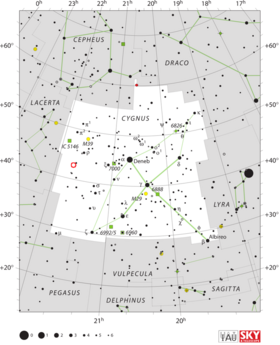Astronomy:Q Cygni
| Observation data Equinox J2000.0]] (ICRS) | |
|---|---|
| Constellation | Cygnus |
| Right ascension | 21h 41m 43.928s[1] |
| Declination | 42° 50′ 29.04″[1] |
| Apparent magnitude (V) | 3.0 - 15.6[2] |
| Characteristics | |
| Spectral type | K5[3] |
| Variable type | Nova[2] |
| Astrometry | |
| Parallax (π) | 0.729 ± 0.024[4] mas |
| Distance | 1372+51 −42[4] (741[5] - 3,300[6]) pc |
| Absolute magnitude (MV) | −9.1 - +2.9[4] |
| Details | |
| White dwarf | |
| Mass | 0.8[5] M☉ |
| Surface gravity (log g) | 8.5[5] cgs |
| Temperature | 31,000[5] K |
| secondary | |
| Mass | 0.6[3] M☉ |
| Other designations | |
| Database references | |
| SIMBAD | data |

Q Cygni (Q Cyg), is a star located in the constellation Cygnus. It is also known as Nova Cygni 1876, and has the designation NGC 7114, and HR 8296. Nova Cygni is located in the northwestern portion of Cygnus along the border with Lacerta.
One of the earliest novae recorded,[6] Q Cygni was discovered by astronomer Johann Friedrich Julius Schmidt on November 24, 1876.[9] The star had undergone a nova, brightening to about 3rd magnitude and remaining as bright for four days.[6]
The system is termed a cataclysmic variable,[3] composed of a white dwarf in close orbit with another star that orbit each other every 10 hours. The white dwarf is surrounded by an accretion disc, which blazes much brighter than the star it circles. The system has been estimated to be 740 ± 11 parsecs distant.[5] The secondary star has been estimated to be around 0.6 times as massive as the Sun, making it an orange dwarf of spectral type K5.[3] Also known as a donor star, the secondary supplies mass to the white dwarf via its accretion disc.[3]
A small nebulous disc was reported around the nova and this led to it being listed in the New General Catalogue as a possible planetary nebula. No nebulosity is visible in modern observations and the Revised New General Catalogue lists this as a "non-existent" object.[10]
References
- ↑ 1.0 1.1 Brown, A. G. A. (August 2018). "Gaia Data Release 2: Summary of the contents and survey properties". Astronomy & Astrophysics 616: A1. doi:10.1051/0004-6361/201833051. Bibcode: 2018A&A...616A...1G. Gaia DR2 record for this source at VizieR.
- ↑ 2.0 2.1 Samus, N. N. et al. (2009). "VizieR Online Data Catalog: General Catalogue of Variable Stars (Samus+ 2007-2013)". VizieR On-line Data Catalog: B/GCVS. Originally Published in: 2009yCat....102025S 1. Bibcode: 2009yCat....102025S.
- ↑ 3.0 3.1 3.2 3.3 3.4 Peters, Christopher S.; Thorstensen, John R. (2006). "Spectroscopy of Five Old Novae: New or Refined Orbital Periods". The Publications of the Astronomical Society of the Pacific 118 (843): 687. doi:10.1086/504641. Bibcode: 2006PASP..118..687P.
- ↑ 4.0 4.1 4.2 Schaefer, Bradley E. (2018). "The distances to Novae as seen by Gaia". Monthly Notices of the Royal Astronomical Society 481 (3): 3033–3051. doi:10.1093/mnras/sty2388. Bibcode: 2018MNRAS.481.3033S.
- ↑ 5.0 5.1 5.2 5.3 5.4 Kolobow, Craig; Sion, Edward (2011). "The Amazing Old Nova Q Cygni: A Far-Ultraviolet Synthetic Spectral Analysis". Publications of the Astronomical Society of the Pacific 123 (906): 892–94. doi:10.1086/661235. Bibcode: 2011PASP..123..892K.
- ↑ 6.0 6.1 6.2 Kafka, S.; Tappert, C.; Honeycutt, R. K.; Bianchini, A. (2003). "Spectroscopic Study of Q Cygni: Surprises from an Old Nova". The Astronomical Journal 126 (3): 1472–82. doi:10.1086/377020. Bibcode: 2003AJ....126.1472K.
- ↑ Schmidt, Johann Friedrich Julius (January 1877). "Über den neuen Stern im Schwan". Astronomische Nachrichten 89 (3): 41. doi:10.1002/asna.18770890304. Bibcode: 1877AN.....89...41S.
- ↑ Lockyer, J. Norman (January 1891). "On the Causes which Produce the Phenomena of New Stars". Philosophical Transactions of the Royal Society of London, Series A 182: 397–448. doi:10.1098/rsta.1891.0011. Bibcode: 1891RSPTA.182..397L.
- ↑ Duerbeck, Hilmar W. (March 1987). "A Reference Catalogue and Atlas of Galactic Novae". Space Science Reviews 45 (1–2): 1–14. doi:10.1007/BF00187826. Bibcode: 1987SSRv...45....1D.
- ↑ "NGC 7000 - 7840". http://www.astronomy-mall.com/Adventures.In.Deep.Space/NGC%207000-7840.html.
External links
 |


